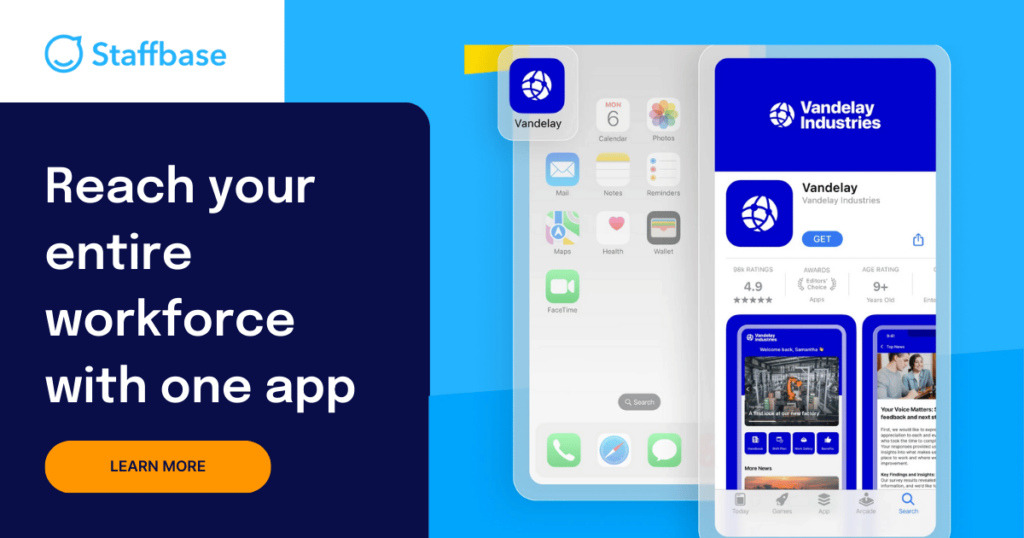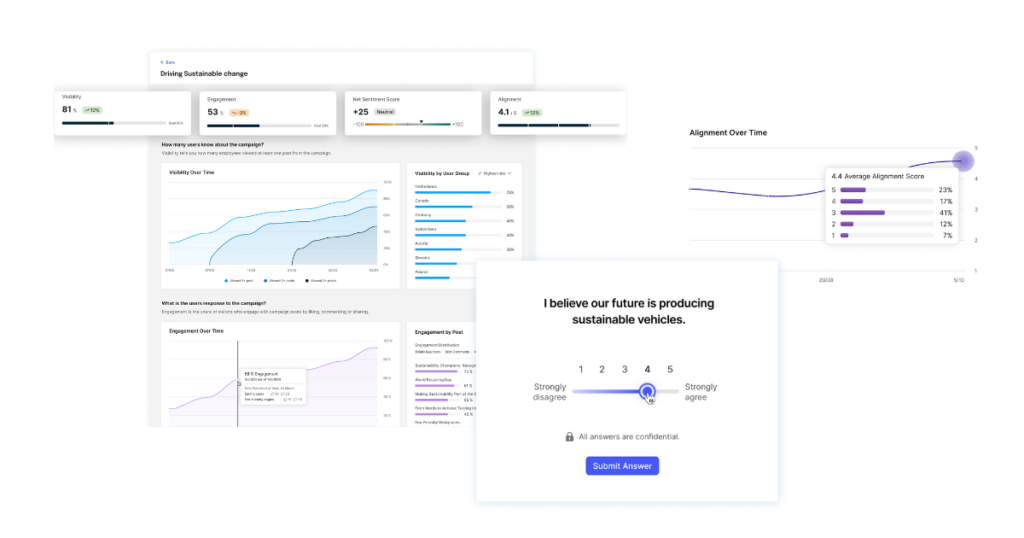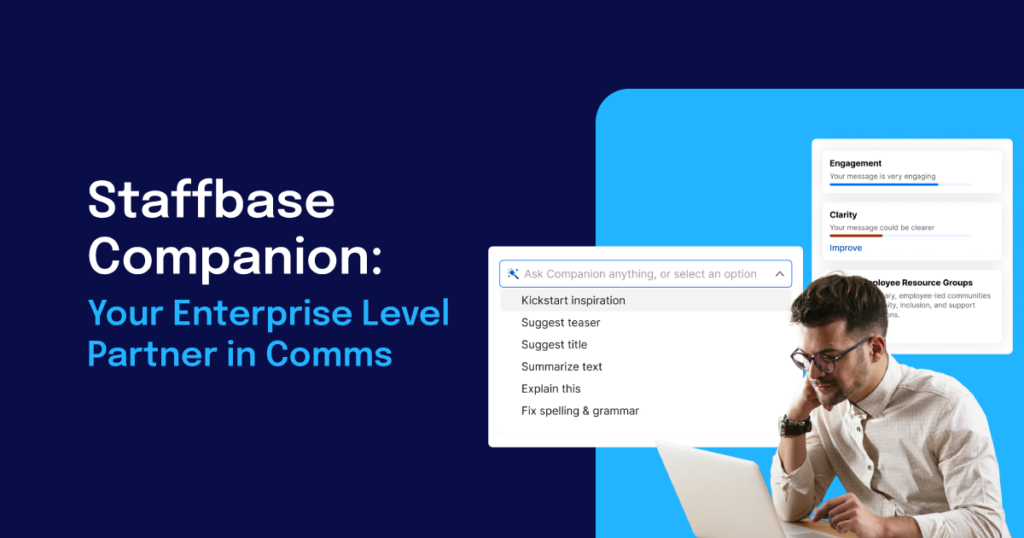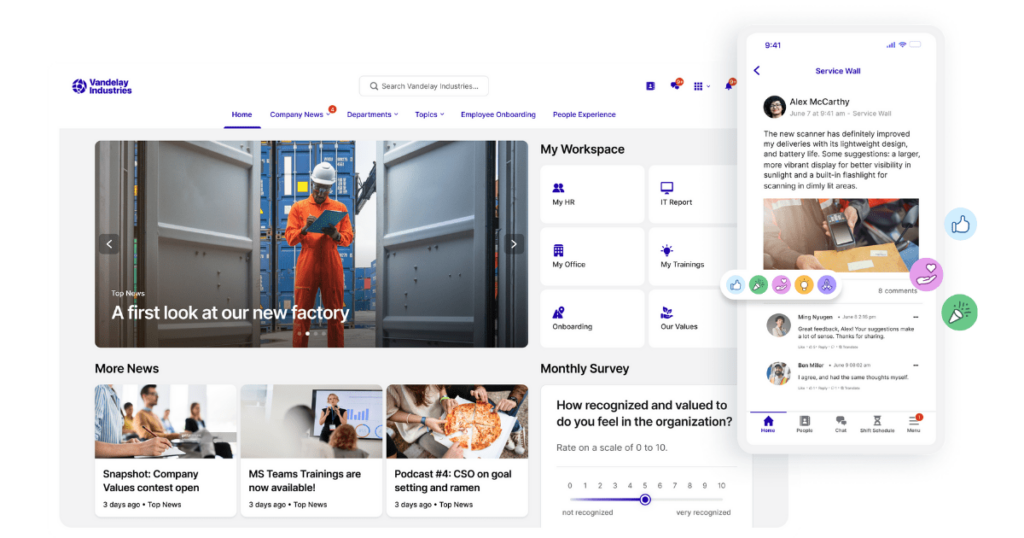Effective communication is crucial to business success — but it’s only possible with the right tools. In this article, we’ll share our top 10 business communication tools, plus some of the biggest benefits they can bring to an organization.
What is a communication tool?
Communication tools are apps or software that allow employees to communicate with each other. This is a wide category of workplace tools, which includes everything from collaboration and project management software to tools that enable strategic, top-down communication. Communication tools may be designed for synchronous or asynchronous communication.
Most companies need several IT communication tools to properly meet all of their needs. In an ideal world, these all integrate smoothly with each other, providing a seamless and consistent communication experience across different platforms.
The importance of communication tools for your business
Effective communication in the workplace is only possible with the right tools — especially in the era of remote work. But according to a study by Slack, only 31% of employees are “extremely satisfied” with their current work communication tools.
Without the right tools, it’s impossible for teammates to collaborate effectively on projects, especially if they’re working remotely. This can have a big impact on productivity and employee satisfaction. Not having the right communication tools in place can also make it difficult to deliver effective top-down communications — and understand if your message is getting through.
Plus, a lack of effective business communication tools makes it harder for your employees to engage and connect with each other — and with your organization’s core vision and values. This can have a detrimental effect on your company culture, and lead to a drop in employee morale and engagement.
In short, effective communication of all types can have a huge positive impact on your organization and its employees. And having the right tools to facilitate that communication is crucial.
Top features to look for in a communication tool
Different types of communication tools come with distinct features and functionalities. For example, some are optimized for strategic top-down or HR-led communications, whereas others are designed to enable collaboration and connection between employees. That said, there are some key features that are common among the best IT communication tools. Here are a few things to look out for.
Mobile and desktop access
Communication tools should be accessible to all of your employees — not just those who work behind a desk. That means that mobile access is crucial. To ensure your frontline and remote workers can benefit from your communications tools, look for solutions that include a mobile app.

Integrations with other key tools
In almost every workplace, employees use a variety of apps, tools, and software to get their jobs done. If you’re introducing a new communication tool to the mix, you need to be sure it will work alongside the programs your employees already use. The best communication tools come with built-in integrations with other common work software, which can help drive adoption and make workflows smooth and seamless.
Analytics and reporting
The most powerful communication tools come with built-in analytics and reporting features that allow admins to understand exactly how employees are using them. With the right insights, you’ll be able to hone your communications over time and ensure they’re having the desired impact on your organization.

Security and compliance
The whole point of a communication tool is to facilitate the sharing of information. And you need to be 100% sure that any communication tool you adopt will keep that information safe and secure. To avoid putting your business at risk, look for tools that are GDPR-compliant (in the EU) and have security certifications like ISO 27001 and SOC 2.
AI capabilities
Modern communications tools sometimes come with built-in AI capabilities, which can speed up manual processes and enhance employee engagement. However, it’s important to remember that employee communications are fundamentally about human connection — which can’t be replaced by a Large Language Model. Look for tools that use AI responsibly to drive real value for their users.

Different types of business communication tools every company needs
Most companies need a range of communication tools to effectively manage their operations. Here are some of the different types of communication tools you could consider adding to your tech stack:
Company intranet: An intranet is an internal network that allows employees to easily access company information, documents, and resources, as well as important communications from leadership. Some intranets include social elements like communities and news feeds populated with employee-generated content.
Employee app: Employee apps allow remote and frontline employees to connect with the organization, wherever they are. They can be downloaded on an employee’s work or personal device, and are crucial if you want to engage every employee with your internal communications.
File-sharing software: This type of tool allows employees to securely share, access, search for, and transfer documents and other files. You can think of them as a modern, more secure version of the office filing cabinet — essential in a world where many employees work remotely.
Collaboration tools: These tools help team members to effectively collaborate on shared tasks and projects, even when they’re working from different locations. They may come with features like simultaneous document editing, comments and mentions, and integrations with other workplace communication tools.
Instant messaging tools: Instant messaging apps allow employees in all locations to communicate, connect, and chat in real-time, either one-on-one or in groups. This allows for a faster exchange of information than clunky solutions like email, enhancing productivity and efficiency.
Video conferencing software: In today’s world of remote work, software for secure video meetings is essential. Not only does it allow teams to effectively manage projects, but it can also help to keep everyone engaged and connected, even when they’re physically apart.
Task and project management tools: These tools help to keep teams on track when they’re working on shared projects. They’re typically very visual, allowing users to quickly understand project progress and easily figure out who is responsible for which tasks. Some tools come with built-in automation features, which can help to improve efficiency.
The top 10 communication tools to try
These days, there are so many workplace communication tools available that it can be difficult to know where to start. And, since each one is designed to serve a specific function, the reality is that you’ll probably need more than one tool to meet all of your needs.
To help you get started, we’ve put together this list of some of the best communication tools on the market.
Staffbase
Best for: Powerful, multi-directional, multi-channel communications for desk-based and frontline employees.
Staffbase is a leading employee communication platform, combining peer-to-peer engagement, employee feedback, and strategic, top-down communications. These are delivered through a range of channels including intranet, email, and SMS, all controlled through one centralized dashboard.
Thanks to Staffbase’s branded employee apps, frontline employees aren’t left out of internal communications. Staffbase can help internal communications teams drive action, unlock employee engagement, and encourage employees to connect with the organization and its core mission and values.

Key features
Multiple communication channels including intranet, email, employee apps, and SMS, all managed through a central control center
Tailored content paths to provide employees with the right information at the right moment in the employee lifecycle
Robust admin controls allowing admins to prioritize and highlight the most relevant content and campaigns so corporate messaging doesn’t get lost in the noise
Advanced analytics dashboards for actionable insights measurable communications
Flexible, two-way Microsoft 365 integrations for smooth and seamless workflows
AI companion to save time for admins and users and enhance employee engagement with corporate communications
Pros and cons
Enables businesses to effectively connect with all employees, whether in-office, remote, or frontline
Advanced features for strategic communications, including topic planning, collaboration, and goal tracking
Intuitive, user-friendly design and branded mobile apps lead to high adoption, including frontline workers
Combines peer-to-peer social interactions, employee feedback, and strategic communications in one product suite
Pricing
Staffbase has three main pricing plans, tailored to different business sizes and needs:
SMB: For companies with up to 100 employees, including a branded mobile app, push and email notifications, news feeds, and more.
Business: All of the above plus AI Companion, auto-translation, advanced analytics, editorial calendar, customization options, and APIs.
Enterprise: All business plan features, plus campaigns, ghostwriting, automated journeys, local content management (Spaces), and custom app distribution options.
For more information, visit our pricing page.
Slack
Best for: Communicating and collaborating in real-time.
Slack is a user-friendly tool designed for one-on-one and channel-based instant messaging. It’s ideal for teams that want to communicate on work projects in real-time. The platform also includes a basic function for video meetings, as well as integrations with many workplace tools.
Key features
Channel-based messaging for specific departments, projects, or topics.
Third-party integrations with a wide range of apps and services, including Google Workspace, Microsoft 365, Salesforce, Notion, and more
Custom bots and automated workflows through the Slack API
AI assistant to summarize long conversations, help users find answers to questions, and provide daily channel recaps
Pros and cons
Highly intuitive user interface
Extensive customization options
Channels can become noisy and distracting
Corporate communications can get lost in the shuffle
Pricing
Slack has three pricing levels, geared toward businesses of different sizes:
Standard: $7.25 per user per month
Business+: $12.50 per user per month
Enterprise Grid: Custom pricing
Zoom
Best for: Businesses that prioritize face-to-face interactions.
Over the last few years, Zoom has become the tool for video conferencing. Users can easily connect to meetings through an internet browser or the desktop or mobile app. There’s even a dial-in option for those without an internet connection. Zoom also comes with many features designed to make virtual meetings more convenient and productive, including file-sharing, chat, screen-sharing, reactions, and more.
Key features
Voice and video conferencing for up to 500 participants (depending on package)
Easy meeting recording feature to keep everyone in the loop
Key integrations including Google Drive, OneDrive, Sharepoint, Jira, and more
AI companion providing automatic meeting and chat thread summaries and message generation
Pros and cons
Available on web, desktop, and mobile
Supports large audiences
Not suitable for communication with deskless workers
Encourages unnecessary video meetings (“Zoom fatigue”)
Pricing
Zoom offers a freemium package with limited features, which allows meetings of up to 40 minutes with up to 100 participants. Paid packages are priced in three tiers:
Pro: $13.32 per user per month
Business: $13.32 per user per month
Business+: Custom pricing
Confluence
Best for: Companies using Agile methodology or other Atlassian products.
Confluence is a collaboration and content-sharing platform developed by software company Atlassian. It’s built around “spaces,” which are central hubs for each team or department. Users can then create “pages” for specific projects and use them to collaborate in real time. Confluence is built around Agile methodology and pairs well with other Atlassian software, including work management tool Jira.
Key features
Easy collaboration through pages and spaces
Extensive catalog of page templates
Collaboration features including file, inline, and page comments and mentions
Advanced search function
600+ integrations available through the Atlassian marketplace
Pros and cons
Smooth integrations with other Atlassian products including Jira and Trello
Powerful knowledge base features including page hierarchy, labels, and search
Steep learning curve for non-technical users
No functionality for strategic communications
Pricing
Confluence is free for up to 10 users. For larger teams, there are three pricing levels:
Standard: $14,500 per year for up to 300 users
Premium: $26,900 per year for up to 300 users
Enterprise: Custom pricing, up to 800 users
Monday.com
Best for: Collaborating on projects with multiple users, when coupled with other communication tools.
Monday.com is a project management tool that makes it easier for teams to work together on shared projects. Team leads can break down projects into smaller tasks, and then assign each one to the relevant employee. Team members receive notifications when action is required. Monday.com’s intuitive visual interface makes it easy to understand project progress at a glance.
Key features
Task management features including task assignment, color-coding, mentions, and comments
Integrations with Google Drive and Dropbox, making it easy to share files within the platform
72+ integrations including Slack, Jira, Github, and Trello
No-code automations that auto-complete processes based on triggers
Pros and cons
Available in 14 languages
Intuitive and user-friendly interface
Limited internal communication features
Designed for team collaboration — not useful as a standalone corporate communication tool
Pricing
Monday.com offers four pricing levels for different company sizes and needs:
Basic: $9 per month per 3 users
Standard: $12 per month per 3 users
Pro: $19 per month per 3 users
Enterprise: Custom pricing
Dropbox
Best for: Securely sharing files and knowledge within large organizations.
Dropbox is a secure knowledge management system that allows teams to easily share, store, and transfer files and documents. Administrators can set up permissions to ensure only the right people have access to particular files, and set passwords and expiry dates to ensure security. Dropbox has also introduced several new features that make the platform even more powerful, including Showcase, which allows users to share work with clients, and Dropbox Paper, which enables team collaboration.
Key features
Secure document storage and robust file management, including automated folders, tagging, and sorting
File and version recovery
File transfers of up to 250GB (depending on plan)
Insights dashboard where admins can monitor team activity, view connected devices, and audit external sharing
Pros and cons
Makes it easy for teams to access files and information from anywhere
Dropbox Paper features to facilitate remote collaboration
Could be too expensive for small businesses
No features for company-wide communication
Pricing
Dropbox has a free basic plan with limited features and two additional paid levels for individual users. For businesses, there are three pricing tiers:
Business: $12 per user per month
Business Plus: $18 per user per month
Enterprise: Custom pricing
ContactMonkey
Best for: Teams already using Outlook or Gmail and looking to increase engagement.
ContactMonkey is a communication tool that enables internal communications professionals to create more engaging email comms. The tool integrates with both Outlook and Gmail. It also includes the functionality for SMS communications, meaning it can be used to engage both desk-based and frontline workers. The built-in analytics and surveys allow administrators to track engagement and gather feedback, honing their communications over time.
Key features
Drag-and-drop email builder and personalized templates to create engaging emails
Built-in analytics and survey tools to gather feedback and measure engagement
Smooth integration with Outlook and Gmail
OpenAI integration for translation and content creation
Pros and cons
Makes it easy to collect feedback and measure engagement
SMS integration for communications with remote and frontline employees
No functionality for peer-to-peer communication
Relies solely on email, which some see as outdated and clunky
Pricing
ContactMonkey does not advertise its pricing but has three plans: Essential, Plus, and Enterprise.
Google Workspace
Best for: Teams looking for a familiar all-in-one collaboration and communication tool with a short learning curve.
Google Workspace (formerly G Suite) is a collection of communication and collaboration tools, optimized for business use. The core package includes Docs, Drive, Sheets, and Slides, which all allow employees to collaborate seamlessly in real-time. It also includes several tools for internal communication, including Gmail, Chat, and Meet. All of these programs work seamlessly with one another, making for smooth and efficient workflows.
Key features
Docs, Sheets, and Slides for documents, spreadsheets, and presentations
Shared calendars and built-in scheduling for meetings and calls
Secure cloud storage through Google Drive
Video conferencing through Google Meet and instant messaging through Chat
Pros and cons
Real-time simultaneous editing for easy collaboration
All-in-one solution with seamless integrations between tools
Limited possibility for strategic top-down comms outside of email
Some integration challenges with non-Google products
Pricing
Google offers several pricing tiers for its Workspace packages, depending on company needs. They are:
Business Starter: $6 per user per month
Business Standard: $12 per user per month
Business Plus: $18 per user per month
Enterprise: Custom pricing
Microsoft Teams
Best for: Enterprises and companies already using the Microsoft 365 Suite.
Microsoft Teams is part of the comprehensive toolset collectively known as Microsoft 365. It’s primarily built for instant messaging, either one-on-one or in teams or channels. Teams also includes a video and audio conferencing function, which allows meetings of up to 300 participants (depending on the plan you choose). Because of its comprehensive feature set and somewhat complex setup process, Microsoft Teams is mostly targeted at enterprise companies.
Key features
Private messaging and channels for team communication
Shared calendars for meetings and built-in scheduling
Video and audio calls with screen- and file-sharing
Web, desktop, and mobile app
Pros and cons
Close integrations with other Microsoft apps
Extensive features for communication and collaboration
Not much functionality for targeted strategic comms
Can be complex to set up without a dedicated IT function
Pricing
Teams is included as part of the Microsoft 365 package, which also includes web and mobile versions of Word, Excel, PowerPoint, and Outlook, alongside numerous other tools. Microsoft offers three core plans for the 365 package:
Business Basic: $6 per user per month
Business Standard: $12.50 per user per month
Business Premium: $22 per user per month
Trello
Best for: Simplifying project management in small to medium organizations.
Trello is a project management tool owned by Atlassian, designed to help teams better collaborate on projects. Each project is built on a board, which is subdivided into cards and checklists. This provides users with a simple bird’s eye view of progress. Tasks can then be assigned to specific members and given a deadline. There’s also an activity log to keep everyone up to date.
Key features
Intuitive Kanban-style boards and cards for each task and project
Over 200 integrations with common workspace apps, including Google Calendar, Microsoft Teams, Dropbox, Confluence, and more
Built-in automation tool to reduce tedious and repetitive tasks with rules and triggers
Range of pre-built templates for different project types
Pros and cons
Easy progress-tracking through Kanban-style boards and cards
Mobile-friendly application
Lacks advanced project management features like time tracking and Gantt charts
May be too simplistic for large organizations requiring more customization
Pricing
Trello offers three paid plans:
Standard: $5 per user per month
Premium: $10 per user per month
Enterprise: $17.50 per user per month
How to choose the right communication tool for your business
Every company’s communication needs are different. And the right tools for your business depend on exactly what you want them to achieve. Here are a few things to keep in mind as you look for communication tools that will suit your business’ size and situation.
Best communication tools for enterprises
As a business grows, its communication needs become more complex. At the enterprise level, you’ll need tools that allow you to reach a wide range of employees who may be onsite, remote, or frontline workers. That means that a mobile and desktop version is crucial.
As a large company, you’ll also need the ability to segment employees into different groups or channels to ensure the communications they receive are relevant and engaging. Since your business likely has an extensive tech stack already, ensuring the tools you choose have a comprehensive range of integrations is also important. Lastly, you should look for tools that will scale with your organization, seamlessly adding new users and functionalities as your business continues to grow.
Best communication tool for global companies
Global businesses have a unique set of considerations when it comes to choosing the right communication tools. First, it’s important to find tools that enable both synchronous and asynchronous communications, since employees may be collaborating across different time zones. Ensuring that the tool you choose offers 24/7 customer support in multiple languages ensures you’ll always have help at hand in case of any problems.
To ensure all employees can access and understand corporate communications and documentation, you may also want to look for tools with built-in translation and multilingual content functionalities. Data security, and compliance also take on a particular significance for multinational businesses since they often share data across borders.
Final thoughts
It’s very likely that your organization will need more than one communication tool. For example, you may have one app for employees to collaborate on projects, and a separate platform for strategic communications from your company’s leadership. That said, you can save yourself a lot of time by looking for solutions that provide more than one communication channel — like an intranet with a built-in employee app, for example.
It’s also important to remember that communication isn’t really effective if it doesn’t reach all of your employees. In today’s distributed world, it’s more important than ever to find tools that are capable of engaging employees, whether they’re in the office, working remotely, or out in the field.



